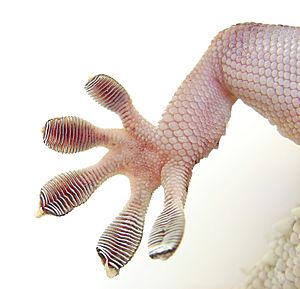Lamella (surface anatomy) facts for kids
A lamella (say "lah-MEL-uh") is a very thin, flat, plate-like part found in living things. Often, you'll find many lamellae grouped together, with small spaces between them. Think of them like tiny, stacked sheets.
These amazing structures help animals in many ways. For example, they help geckos stick to walls, and they help some animals filter their food from water. They are also super important for how fish breathe!
Lamellae in Fish Gills
Fish use lamellae in their gills to breathe underwater. Gills are like the lungs of a fish. They need a huge surface area to take in enough oxygen from the water and get rid of carbon dioxide. Lamellae help create this large surface area.
How Fish Gills Work
In a fish gill, there are two main types of lamellae:
- Primary gill lamellae: These are also called gill filaments. They are long, thin parts that extend out from the main gill arch, which is like the backbone of the gill.
- Secondary gill lamellae: These are even tinier, very thin plates that stick out from the primary gill lamellae. They are where most of the important work of breathing happens.
The tissue of the secondary gill lamellae is incredibly thin, only one cell thick! This makes it easy for gases to pass through.
Countercurrent Exchange
Fish use a clever trick called countercurrent gas exchange at their secondary gill lamellae. Imagine water flowing over the gills in one direction, and blood flowing inside the gills in the opposite direction. This "opposite flow" system is super efficient. It helps the fish take in the maximum amount of oxygen from the water and release carbon dioxide back into it. It's like a special design to make sure the fish gets every bit of air it can!
See also
 In Spanish: Lamela (anatomía) para niños
In Spanish: Lamela (anatomía) para niños
- Pecten (biology) – a similar structure found in birds.



